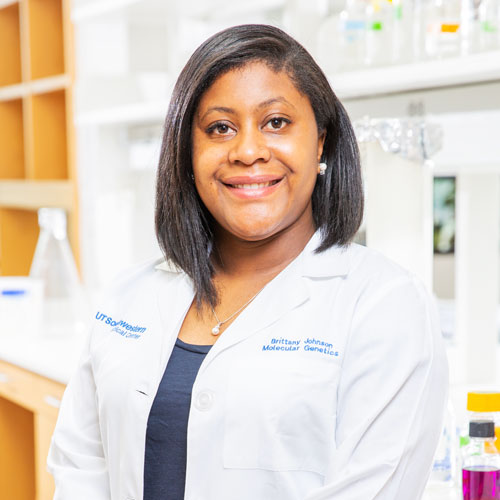Student Profile in Post Translational Regulation of HMG CoA Reductase
Brittany Johnson
Mechanisms of Disease and Translational Science Graduate Track
Mentor: Russell Debose-Boyd, Ph.D.
Undergraduate Degree: Cell and Molecular Biology
Undergraduate Institution: San Francisco State University
Hometown: Marina, Calif.
Awards/Fellowships:
Doctorate: HHMI Gilliam Fellowship for Advanced Study
Master’s: Genentech Foundation MS Dissertation Scholarship
Sally Casanova Pre-Doctoral Scholarship
NIH MBRS-Research Initiative for Scientific Enrichment (RISE)
Bachelor’s: Minority Access to Research Careers (MARC)
NIH MBRS Research Initiative for Scientific Enrichment (RISE)
California Collegiate Athletic Association All Academic Award
How did you become interested in science and/or research?
I’ve always been interested in science, but it was watching my aunt struggle with lupus that drove me to pursue biology as my field of study in college. I wanted to be the person who figured out how to treat diseases that currently have no available treatment or are difficult to treat so I decided to pursue biomedical research as a career path. I got the opportunity to work in an enzymology lab as an undergraduate and I’ve been hooked ever since.
Please describe your research.
The DeBose-Boyd lab is interested in elucidating molecular mechanisms governing endoplasmic reticulum (ER)-associated degradation (ERAD) of HMG CoA reductase, the rate-limiting enzyme of the mevalonate pathway that produces cholesterol and essential nonsterol isoprenoids. My thesis work involves determining how the vitamin K synthetic enzyme UBIAD1 inhibits ERAD of HMG CoA reductase, allowing cells to continuously produce nonsterol isoprenoids while avoiding the toxic overaccumulation of cholesterol. UBIAD1-mediated inhibition of HMG CoA reductase ERAD significantly contributes to corneal accumulation of cholesterol associated with the eye disease Schnyder corneal dystrophy (SCD). A molecular understanding of mechanisms for ERAD of HMG CoA reductase will not only have important implications for SCD, but also for cholesterol-lowering therapies that may become limited owing to inhibition of ERAD.
Why did you choose UT Southwestern?
I chose to come to UTSW for graduate school for the collaborative environment and excellent research facilities. I also was interested in studying lipid biochemistry, and UTSW is excellent in this area.
What do you think makes the Mechanisms of Disease and Translational Science Track one of the best?
The Mechanisms of Disease and Translational Science Track is one of the best programs in the country because we have a strong center for translational medicine, which helps to facilitate collaboration between basic scientists and physicians. Also, physicians are very eager to interact with graduate students and collaborate on projects so we get well-balanced training in bench-to-bedside research.
– Brittany Johnson, Mechanisms of Disease and Translational Science Graduate Track

